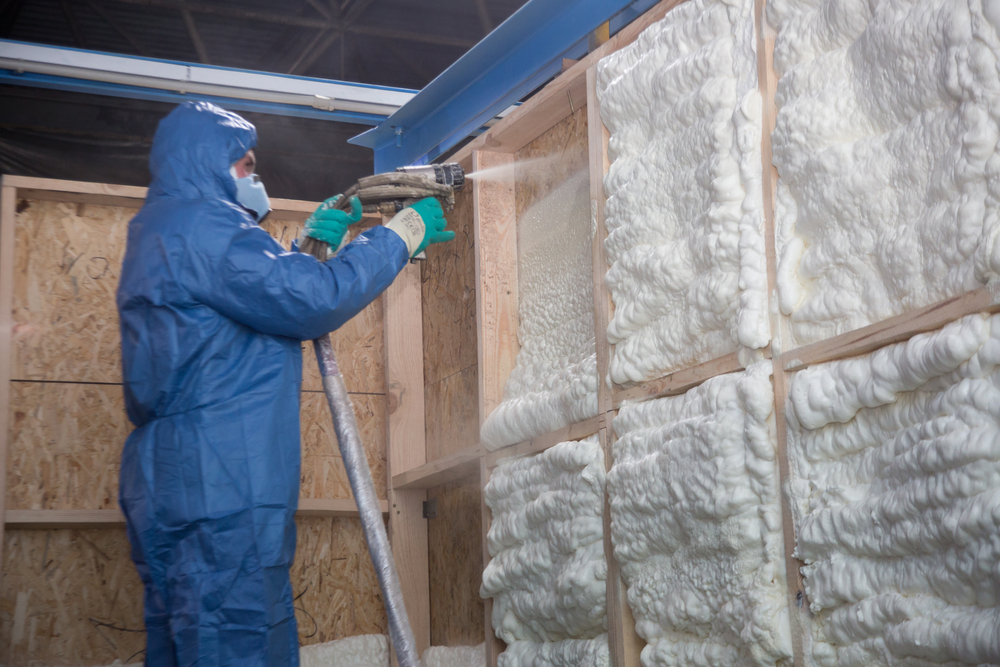Water leaks cause all sorts of damage, from ruining your floors and walls to causing mold growth. Plus, they raise your water bill and damage the drywall.
Insulating materials, such as fiberglass and cellulose, don’t necessarily waterproof your home, but they can help to prevent moisture from seeping in. They also help keep your home warmer in the winter and cooler in the summer, saving you money on your energy bills.
When comparing the two, spray foam does a better job of sealing out water than fiberglass. Let’s take a look at how.
Does Spray Foam Insulation Stop Water?
While the answer is yes, it’s essential to take it with a grain of salt. Many factors can contribute to whether or not your spray foam insulation will be effective in stopping water leaks.
For one, the type of spray foam you use matters. There are two main types of spray foam: closed-cell and open-cell. Closed-cell spray foam is denser than open-cell spray foam. That means it does a better job of filling in gaps and cracks. As a result, closed-cell spray foam is better at stopping water leaks.
Secondly, how the spray foam is installed is essential. If there are any gaps or openings in the insulation, water can seep through. That’s why it’s crucial to have a professional install your spray foam insulation.
Spray foam forms an air-tight seal that helps to prevent water leaks. But it’s not foolproof.
For one, just because spray foam keeps water out doesn’t mean water magically disappears. Instead, it’s merely pooling up somewhere else, which can lead to other problems down the line.
Over time, wear and tear can cause small cracks and openings in spray foam insulation. These need to be regularly inspected and repaired to prevent water leaks.
It’s also important to note that spray foam is not a solution for all water leaks. For example, if your home has significant structural problems, such as cracks in the foundation, spray foam insulation will not be able to fix that.
Ideally, you need to fix the root cause of the problem before insulation can be effective.
Where Can You Use Spray Foam To Seal Out Water?
There are a few scenarios where using spray foam to seal out water can work. Here are some of them.
Around Windows and Doors
If the climate in your area is such that you often get heavy rains or snow, you know how water can seep in through cracks around your windows and doors. By using spray foam around the perimeter of these openings, you can keep water from seeping in and damaging your home.
In the Attic
The attic is the most likely place for water to enter your home, so it makes sense to use spray foam here. You can seal around the edges of your attic door and also around any vents or other openings.
Besides keeping moisture out, spray foam also prevents rodent infestation. It’s also a noise-reducing material, so it will make your home quieter.
Roof Leaks
If your roof has a minor leak, you can use spray foam to seal it. Just be sure to fix the cause of the leak first, or the problem will just keep happening.
For instance, if a shingle has come loose, replace it before you seal the area with spray foam. Otherwise, the water will pool behind the spray foam and eventually cause the seal to fail.
Spray foam won’t keep the water out in cases of major leaks. For example, if a storm has caused serious damage to your roof and you can see daylight through the hole, you’ll need to patch the roof first and then use spray foam to seal it.
Are There Better Alternatives to Spray Foam to Seal Out Water?
Spray foam is the only product on the market that can simultaneously insulate and seal out moisture. Other insulating materials, such as fiberglass, merely provide a barrier against heat loss but do nothing to prevent moisture from entering the home.
Likewise, products that claim to seal out moisture, such as tar paper, tar paper, or house wrap, do not provide any insulation value. Even if you use fiberglass with a vapor retarder, you will not achieve the energy efficiency of closed-cell spray foam.
That’s because closed-cell spray foam completely seals any cracks or gaps in the home’s envelope, making it the most effective way to prevent air and moisture infiltration.
On the other hand, fiberglass batts and other insulation products leave tiny spaces around electrical outlets, baseboards, and other areas where the material is cut or fit.
These gaps allow moisture to penetrate the home’s envelope, leading to mold growth and other problems. The only other product that comes close to the performance of spray foam is rigid foam board insulation, but it is not as easy to install and does not provide the same level of air sealing.





